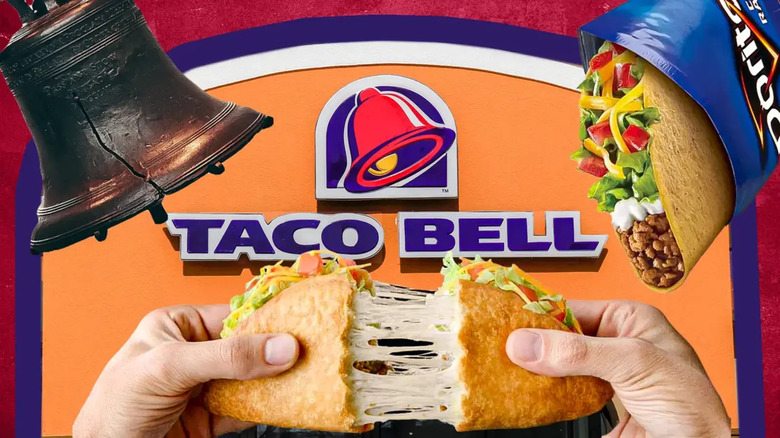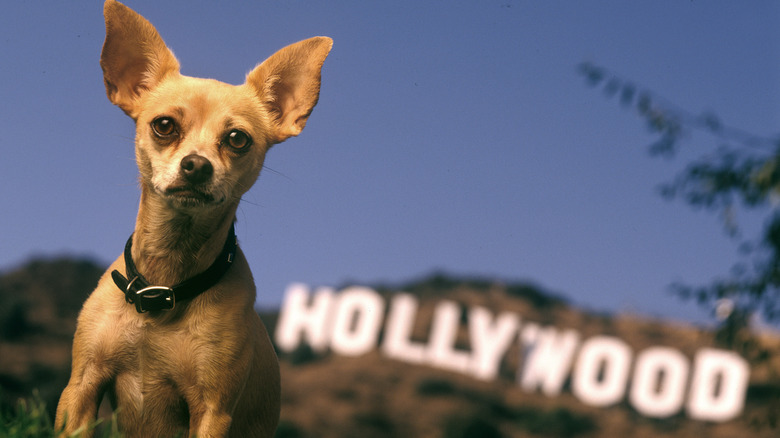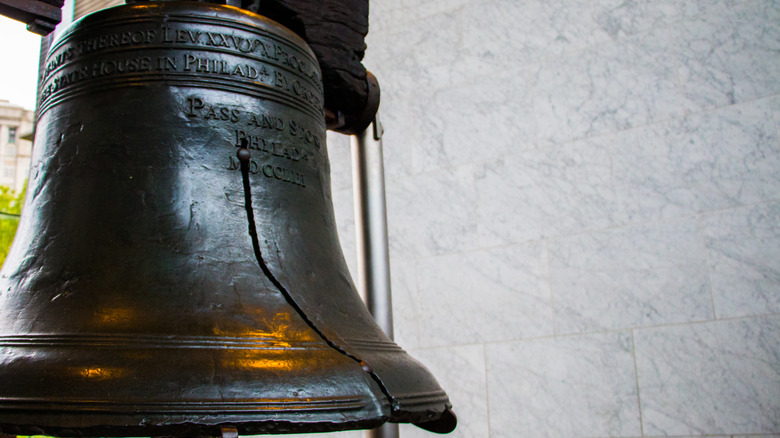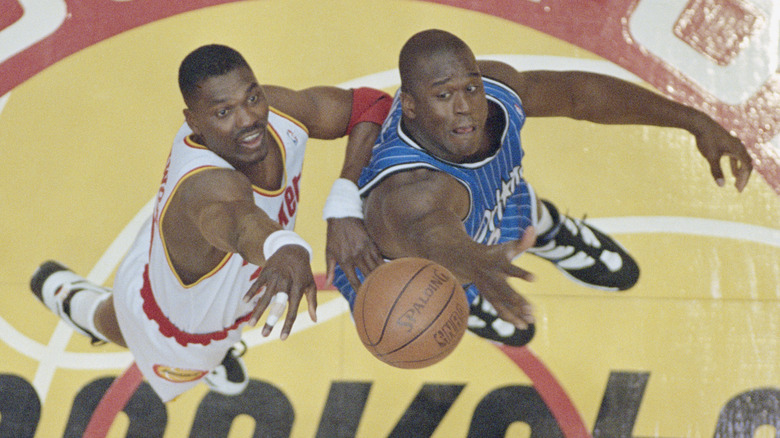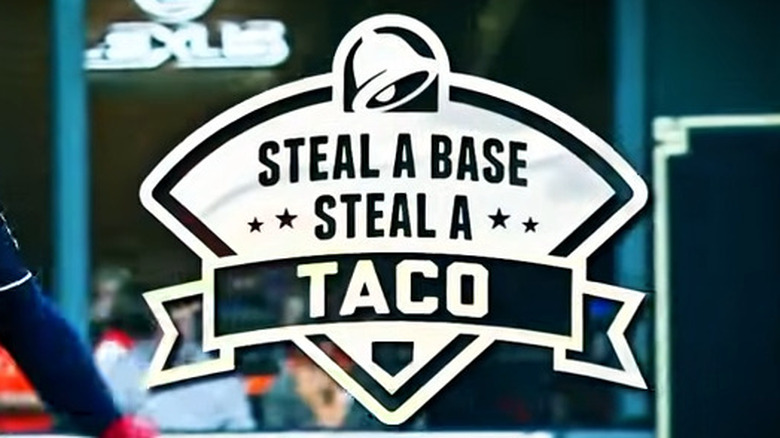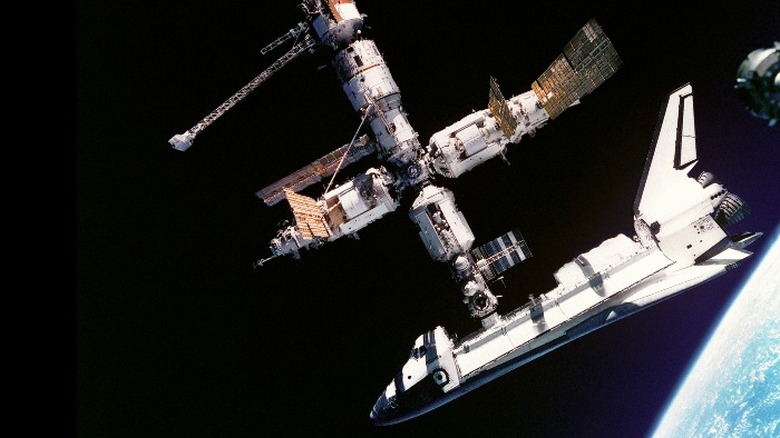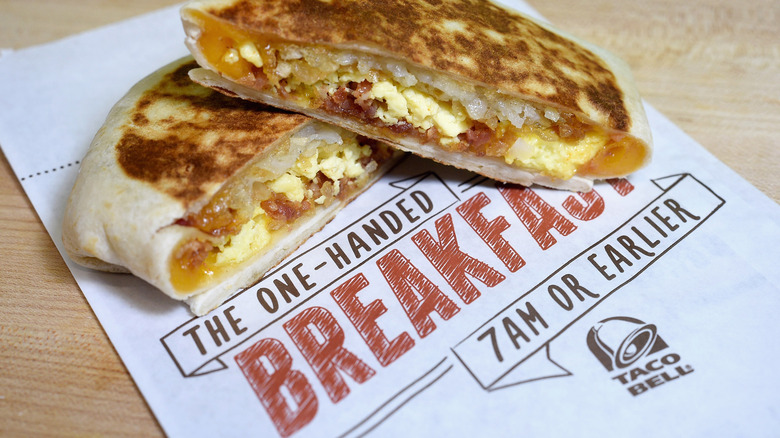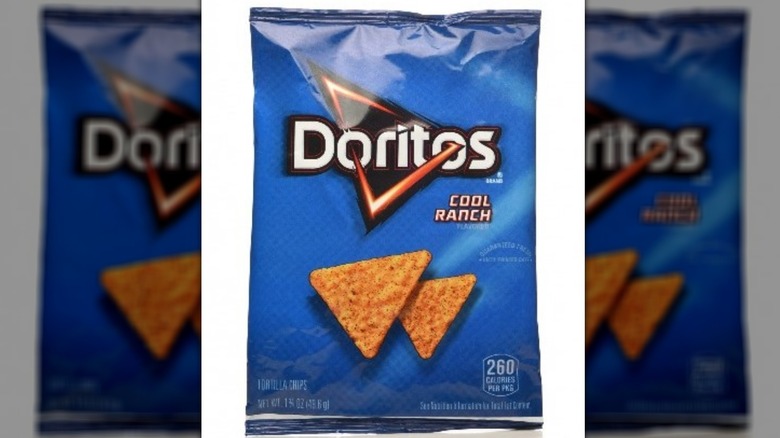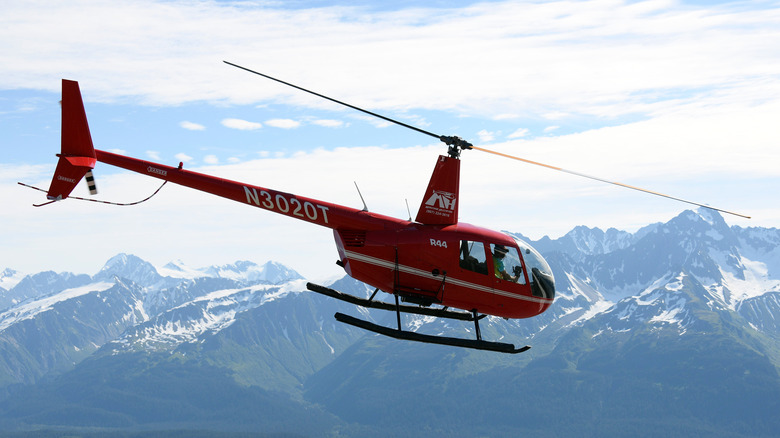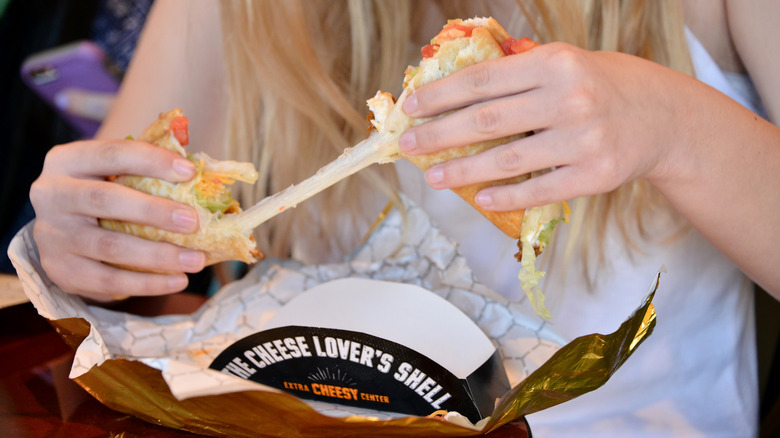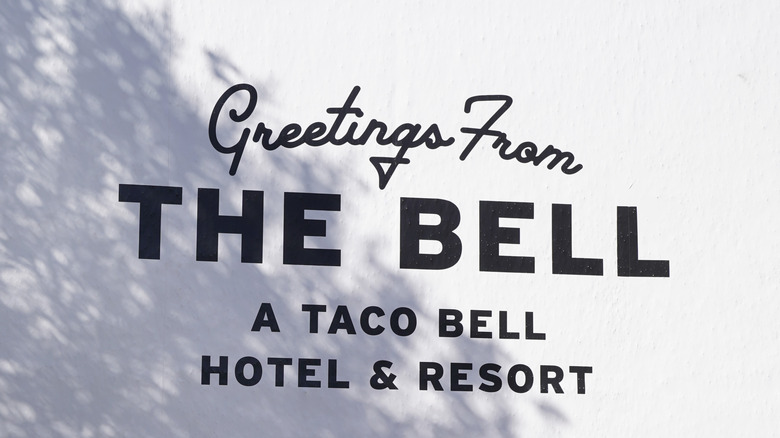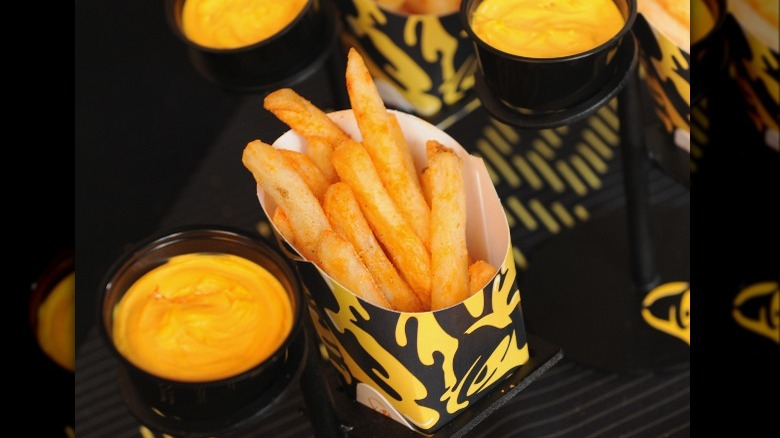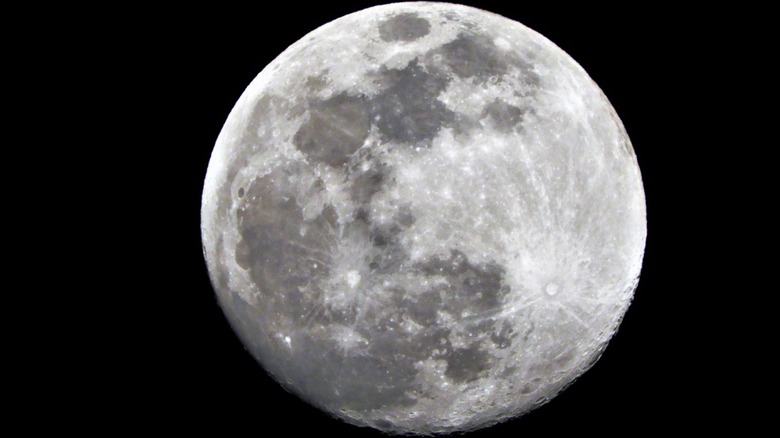Taco Bell's Spiciest Marketing Campaigns Of All Time
Just as Taco Bell is no stranger to advertising blitzes, U.S. consumers are no stranger to the fast food chain's seemingly ubiquitous attempts to remain ever present in the public eye. Frankly, unless you've spent the past few decades living in an underground bunker — a la Kimmy the Unbreakable (Ellie Kemper) — you're almost certainly well-acquainted with the Bell's many attempts to ensure we never (ever) forget to live más.
Not that we're complaining. After all, Taco Bell's delectably scrumptious collection of Mexican classics and outside-the-bun concoctions make it (arguably) peerless in the quick-service restaurant industry. More than that, though, its innate impulse to go big and bold at all times (with both its food and marketing strategies) has spurred the creation of some truly memorable — and, might we say, spicy — advertisements throughout its existence.
In fact, a number of the chain's more noteworthy marketing campaigns have been positively picante — as is befitting a restaurant known for selling south-of-the-border culinary fare. With that in mind (and with beads of sweat forming along our brow from the heat), let's take a stroll down memory lane and revisit some of the most unforgettable ads from the fast food joint's history. Before we run to the kitchen to chug a glass of milk to relieve our burning tongue, allow us to reveal Taco Bell's spiciest marketing campaigns of all time.
'Yo quiero, Taco Bell'
Who's the most famous Gidget to grace the silver screen in U.S. history? If you said Sally Field, you not only (inadvertently?) revealed your true age, but you also demonstrated you don't write about food for a living. After all, for us at Mashed, no famous female embodies that name more than Gidget the chihuahua — the teeny, tiny fast food spokesdog who lit up the late-1990s with four simple words: "Yo quiero, Taco Bell."
Anyone who lived through the final years of the Clinton presidency undoubtedly recalls this adorable canine's commercials as well as the associated merchandise, like a talking plush dog (which this writer owned). Of course, we'd forgive anyone unaware the Taco Bell chihuahua was actually a female — considering the character was memorably voiced by male actor Carlos Alazraqui throughout its relatively brief run in the spotlight.
Now, while we'll never forget the late Gidget (who passed away in 2009 at age 15), or her time on our television screens, not everyone was thrilled with the massive marketing campaign. For one thing, accusations of racial insensitivity (for portraying an offensive Latino stereotype) hounded the fast food chain, as did a long-running legal dispute regarding the Taco Bell chihuahua's creation. Consequently, the plug was pulled on the ads after several years, and Gidget's final appearance came in 2000.
Taco Bell supposedly buys the Liberty Bell
Certain events in life are so monumental that they leave an indelible impression. For millennials (that oft-forgotten, never-written about generation), few moments were as consequential as the day Taco Bell went all in on its name and purchased the Liberty Bell ... not! After all (timely '90s joke side), everyone knows Taco Bell never actually bought the nation's cracked symbol of freedom. But on April 1, 1996, the fast food chain pulled off an all-time April Fool's joke — and top-drawer marketing campaign — by releasing a series of newspaper ads stating it was, in fact, the new owner of the Liberty Bell.
Now, it's hard to believe anyone would take this patently absurd claim at face value — mainly because the Liberty Bell wasn't (and isn't) for sale. But for a brief moment in time? Taco Bell's clever ploy worked. In fact, some gullible folks were completely fooled by the ad, which stated the company made the purchase "in an effort to help the national debt" and declared the national treasure would "now be called the 'Taco Liberty Bell.'" Those who fell for the gag were understandably enraged.
Of course, after then-National Park Service Director Roger Kennedy squashed the rumor, the uproar subsided. And while the Liberty Bell still resides outside Independence Hall in Philadelphia, Pennsylvania (rather than nestled in the lobby of Taco Bell's headquarters), the memory of this stunt lingers like a jalapeño on the palate.
Shaq versus Hakeem 'the Dream'
Even though the Houston Rockets swept the Orlando Magic in the 1995 NBA Finals, basketball fans were eager to see the Rockets' Hakeem Olajuwon face off once more against the Magic's Shaquille O'Neal — and it's easy to see why. After all, the Hall of Famers aren't just two of the best centers to ever play the sport, but two of the greatest basketball players of all time period. So, several months after that year's finals, Taco Bell scheduled a one-on-one pay-per-view contest between Olajuwon and O'Neal for September 30, 1995.
Set to take place at the Taj Mahal in Atlantic City, New Jersey — no doubt pleasing the ghost of Nucky Thompson (Steve Buscemi) — Taco Bell spent months promoting the game between the two All-NBA Team centers. Unfortunately, only hours before the scheduled contest was set to ensue, Olajuwon was forced to withdraw due to an injury, putting the kibosh on the highly anticipated rematch.
Now, despite the disbelief from some regarding Olajuwon's back injury, we're not prone to question Hakeem "the Dream" — or his toughness. So while we certainly wish we'd been able to witness him go one-on-one with Shaq back in 1996, the fact we're still discussing it nearly 30 years later illustrates the marketing campaign's all-time effectiveness.
Steal a base, steal a taco
When a company develops a marketing strategy, does it ever expect that same campaign will still be used (and used successfully) more than 15 years after it launches? Perhaps. Still, if Taco Bell predicted its Steal a Base, Steal a Taco promotion would be more than a one-off appearance upon its 2007 debut, well ... we'd have to color ourselves impressed.
Of course, the now-long-running collaboration with Major League Baseball — held each fall during the World Series — isn't memorable solely because of its longevity (although that helps). Quite frankly, we'd argue it's also the most customer-friendly promotion (from Taco Bell or any other fast food establishment) we've encountered. After all, there's no risk or effort required on the part of customers — just the ability to cash in on a delightful free treat if a player delivers the goods.
Interestingly enough, despite the name, Taco Bell hasn't always offered a taco after a successful stolen base. In 2015, in fact, the restaurant still gave fans a free item after the Kansas City Royals' Lorenzo Cain swiped a bag during Game 1 — but it offered an A.M. Crunchwrap instead (with tacos back in play by 2016). Should baseball fans plan for another year of this iconic (if costly) endeavor from Taco Bell? We can't predict the future — but we wouldn't skip this year's Fall Classic, either.
The Mir space station misses its ocean target
We don't like to overgeneralize, but everyone loves Taco Bell's classic crunchy taco. Now, all kidding aside, that zero-sum declaration is clearly untrue (if for no other reason than the fact that nothing is truly enjoyed by every ... single ... person). Still, considering the crunchy taco was the restaurant's best-selling product as of 2021, there's no denying its widespread popularity. In other words, there's no confusion why the humble taco was chosen as the potential free giveaway during Taco Bell's Mir space station-related marketing campaign in 2001.
That year, the decommissioned Mir space station was set to crash into the Pacific Ocean after completing its mission in orbit. So Taco Bell placed a 40-foot-by-40-foot floating target (adorned with a rinky dink logo) and promised a free taco for everyone in the U.S. if the descending station somehow hit the mark.
Since Mir ended up missing the target (shockingly!), this precursor to the wildly successful Steal a Base, Steal a Taco promotion didn't result in any free tacos. But it certainly got people talking about the fast food chain — and, realistically, that seemed to be the whole point.
Taco Bell enters the breakfast market with a vengeance
Did you know Taco Bell has served breakfast since 2014? Of course you did — because everyone in the world knows about the company's much-ballyhooed entry into the fast food breakfast market that year. Of course, the full-court press presented by the fast food joint in anticipation (and the immediate aftermath) of its breakfast rollout ensured no one missed the arrival of Taco Bell's breakfast.
Actually, a big reason for this advertising strategy's inclusion on our list is the methodology employed by Taco Bell — namely, it went after the competition. One commercial featured numerous Ronald McDonalds – as in actual people with that name, not Mickey D's' famous clown mascot — declaring their preference for Taco Bell over McDonald's. In another, Taco Bell took aim at the Egg McMuffin's supposedly small size and uninspiring taste (two complaints we've never personally had when noshing on a McMuffin).
Now, if all Taco Bell had done upon expanding its menu to the morning hours was announce it was going to start offering breakfast, we wouldn't be discussing it. But with a marketing campaign largely centered on denigrating the competition (McDonald's in particular) as a means of raising its own stature, Taco Bell's initial foray into the breakfast world continues to resonate.
The Cool Ranch Doritos Locos taco bursts onto the scene in 3-D
It's legitimately difficult to quantify how important the Doritos Locos tacos have been to Taco Bell. But it's clear the line of tacos has been staggeringly popular with U.S. consumers since the original Nacho Cheese variety was released in 2012. Of course, the fast food chain recognized the Doritos-taco hybrid was an instant smash. So when it released a Cool Ranch Doritos version in 2013, it chose a marketing campaign worthy of the much-hyped product. But Taco Bell didn't release a simple commercial — it also crafted a three-dimensional ad for movie theaters across the country.
Now, from our vantage point a decade later, it's sort of silly that Taco Bell felt inclined to throw its hat into the 3-D ring. Then again, considering a similar 2-D commercial for the Cool Ranch Doritos taco was playing on cinema screens at the same time, it seems the fast food chain may have simply decided to up the ante for those 3-D moviegoing audiences as well.
The 3-D movie theater commercial wasn't the only plank of its Cool Ranch Doritos tacos launch. But as the first instance of Taco Bell's screen ads leaping past the second dimension, it's one we'll never forget.
Thousands of tacos are flown to Alaska by helicopter
Few prospects are more terrifying to consider than living somewhere devoid of an easily accessible Taco Bell (take that, death and failure!). Unfortunately, this nightmare scenario is a cold, hard reality for residents of Bethel, Alaska, a town nearly 400 miles away from Anchorage, Alaska (and the nearest Taco Bell). Understandably, then, Bethel residents were crestfallen after flyers announcing a new, in-town location in 2012 turned out to be fake. But upon hearing about the scam, Taco Bell seized on the opportunity and flew a literal ton of food to the eager-for-Bell town — enough to make 10,000 Doritos Locos tacos.
Now, unlike every other marketing campaign discussed in this article, shipping all this food by helicopter to a remote Alaskan town didn't begin with Taco Bell itself. Yet the fast food chain is never one to miss an opportunity for viral publicity — or turn down the chance to garner some goodwill with the general public.
We're not entirely sure what the purpose of this mean-spirited prank was (it was the result of a petty dispute between a couple of residents in town). Either way, while folks living in Bethel still don't have a Taco Bell to call their own as of 2023, no one can take away their memories of that glorious 2012 experience.
Taco Bell is way too cheesy (in more ways than one)
Nostalgia is an amazing thing. The power of the past can be intoxicating, after all, driving individuals to take actions they might otherwise never make. Of course, even when we don't necessarily need to be prompted to do something worthwhile — like, say, grabbing a Quesalupa from the closest Taco Bell — we can still enjoy the nostalgic kick. Hence, we loved the chain's exquisitely cheesy marketing campaign welcoming the Quesalupa in 2016: Super Cheesy Dating.
Centered around a collection of faux dating service personal ads (circa the 1990s), the commercial served as a tongue-in-cheek reminder of the Quesalupa's exorbitantly cheesy makeup. The ad featured a series of real Taco Bell fans (dressed in a bevy of glorious '90s era outfits) holding a Quesalupa while proclaiming an appealing (and real) attribute to the camera.
The play on an overly cheesy dating service's similarity to the Quesalupa's excessively cheesy composition may not have been a natural leap. But the hilarious marketing campaign made it clear that didn't matter; in fact, it just made us want a Quesalupa while we chuckled.
Opening a pop-up Taco Bell-themed hotel
As the number of available venues for corporate advertisements has increased throughout the 21st century, Taco Bell has made sure to take advantage of any (and seemingly all) opportunities it encounters. Even the less-obvious routes at a company's disposal have offered a bounty of marketing opportunities for the Mexican fast food spot. In that regard, while some might have been taken aback by the Taco Bell Hotel that briefly opened in 2019, well ... is it really that shocking to anyone with an intimate knowledge of Taco Bell's marketing history?
After the refurbishing of an old hotel in Palm Springs, California, the pop-up spot — called The Bell: A Taco Bell Hotel & Resort — was a hot commodity among Taco Bell boosters. In fact, with a limited-time operation (it was open only from August 8 to August 12 that year), the hotel reached capacity instantly, and all rooms were booked within two minutes.
After the brief run of glory, the Taco Bell Hotel experiment ended, with no indication that The Bell Resort would welcome guests at any future time. Then again, given that the Mexican Pizza triumphantly returned in 2023, perhaps the cause isn't as hopeless as we fear.
Nacho Fries will Fry Again once more
We can understand why Taco Bell has been hesitant to make its otherworldly Nacho Fries a permanent addition to the menu. First off, the item's never-certain status keeps customers from becoming bored with it (as if that was remotely possible). Additionally, the limited-time aspect ensures Nacho Fries remain fresh and exciting each time they return — which opens the item up to some truly wondrous (and clever) marketing campaigns. Case in point: its "Fry Again" fake-movie trailer, a fan-driven collaborative commercial released in 2022.
Now, without addressing whether the "Groundhog Day" trope (where a person repeats the same day over and over again ad nauseam), has jumped the shark, we have to admit there's something endearing about its usage in this context. We fancy ourselves a creative type, after all, but we'd have never dreamed of conceiving "Fry Again" — where Nacho Fries are actually available every day.
Frankly, this marketing campaign is an all-timer for its clever and witty angle. And while we can comprehend the logic of Taco Bell withholding Nacho Fries from the permanent menu, after seeing this commercial? We wish we could fry again every day, too.
Taco Bell goes global with Taco Moon
Realistically, even without reading this article, most folks are aware that a number of Taco Bell's marketing campaigns have been real humdingers — particularly in the 21st century. But did you realize that none of the fast food Mexican chain's famous marketing campaigns had been launched globally before 2021? Of course, being Taco Bell, it had to go over the top with its first worldwide promotion, so it took advantage of the greatest natural marketing tool in the world: the moon.
Now, unlike Pizza Hut (which once considered using a laser to project its logo onto the lunar surface), Taco Bell didn't plan on doing anything specific to the celestial object. In fact, its Taco Moon campaign was actually somewhat understated (for Taco Bell, that is). Launched to coincide with a supposed-new lunar phase, the aforementioned Taco Moon — so-named because, according to Taco Bell, it "really does look like a Taco Bell taco" — the company offered a free taco (of some variety) in more than 20 international markets on May 4, 2021.
No one knows for sure whether the gambit to go global will work in Taco Bell's favor over time. But with no reason to wager against it, we're sure it'll reach new heights with little to no difficulty.
